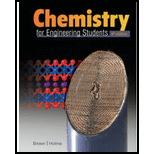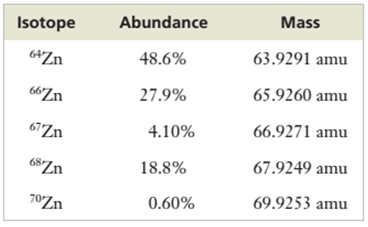
Bundle: Chemistry for Engineering Students, Loose-Leaf Version, 4th + OWLv2 with MindTap Reader with Student Solutions Manual, 1 term (6 months) Printed Access Card
4th Edition
ISBN: 9780357000403
Author: Lawrence S. Brown, Tom Holme
Publisher: Cengage Learning
expand_more
expand_more
format_list_bulleted
Concept explainers
Textbook Question
Chapter 2, Problem 2.18PAE
The following table presents the abundances and masses of the isotopes of zinc. What is the atomic weight of zinc?

Expert Solution & Answer
Trending nowThis is a popular solution!

Students have asked these similar questions
N
Classify each of the following molecules as aromatic, antiaromatic, or nonaromatic.
NH
O aromatic
O antiaromatic
O nonaromatic
O aromatic
O antiaromatic
O nonaromatic
O aromatic
O antiaromatic
O nonaromatic
G
The conjugate base of alkanes is called alkides. Correct?.
Name these organic compounds:
structure
Br
name
CH3
CH3
☐
☐
Chapter 2 Solutions
Bundle: Chemistry for Engineering Students, Loose-Leaf Version, 4th + OWLv2 with MindTap Reader with Student Solutions Manual, 1 term (6 months) Printed Access Card
Ch. 2 - Name at least three common polymers and give...Ch. 2 - Prob. 2COCh. 2 - Describe the nuclear model for the atom and...Ch. 2 - Prob. 4COCh. 2 - Prob. 5COCh. 2 - Prob. 6COCh. 2 - Prob. 7COCh. 2 - Prob. 8COCh. 2 - Prob. 9COCh. 2 - Prob. 10CO
Ch. 2 - Prob. 2.1PAECh. 2 - How do polymers compare to their respective...Ch. 2 - Look around you and identify several objects that...Ch. 2 - Prob. 2.4PAECh. 2 - The fact that a polymer’s physical properties...Ch. 2 - One application of conductive polymers is in...Ch. 2 - Prob. 2.7PAECh. 2 - Prob. 2.8PAECh. 2 - Why is the number of protons called the atomic...Ch. 2 - 2.10 Which isotope in each pair contains more...Ch. 2 - 2.11 Define the term isotope.Ch. 2 - 2.12 Write the complete atomic symbol for each of...Ch. 2 - 2.13 How many electrons, protons, and neutrons are...Ch. 2 - 2.14 Consider the following nuclear symbols. How...Ch. 2 - 2.15 Mercury is 16.716 times more massive than...Ch. 2 - The element gallium, used in gallium arsenide...Ch. 2 - 2.17 The atomic weight of copper is 63.55 amu....Ch. 2 - The following table presents the abundances and...Ch. 2 - 2.19 Naturally occurring uranium consists of two...Ch. 2 - Prob. 2.20PAECh. 2 - Prob. 2.21PAECh. 2 - 2.22 Provide the symbol of the following...Ch. 2 - Prob. 2.23PAECh. 2 - 2.24 Identify each of the following species as an...Ch. 2 - 2.25 Write the atomic symbol for the element whose...Ch. 2 - 2.26 In what region of the periodic table are you...Ch. 2 - Prob. 2.27PAECh. 2 - Prob. 2.28PAECh. 2 - Prob. 2.29PAECh. 2 - 2.30 Using Coulomb’s law, explain how the...Ch. 2 - Prob. 2.31PAECh. 2 - 2.32 Which of the following formulas contains the...Ch. 2 - Prob. 2.33PAECh. 2 - Prob. 2.34PAECh. 2 - Prob. 2.35PAECh. 2 - 2.36 Explain the difference between a molecular...Ch. 2 - 2.37 Why are empirical formulas preferred for...Ch. 2 - 2.38 The molecular formula for the ethylene...Ch. 2 - 239 Polybutadiene is a synthetic elastomer, or...Ch. 2 - 2.40 What distinguished the work of Mendeleev that...Ch. 2 - 2.41 How does the periodic table help to make the...Ch. 2 - 2.42 What is a period in the periodic table? From...Ch. 2 - 2.43 Name of the group to which each of the...Ch. 2 - Prob. 2.44PAECh. 2 - Prob. 2.45PAECh. 2 - 2.46 Why are nonmetals important even though they...Ch. 2 - Prob. 2.47PAECh. 2 - A materials engineer has filed for a patent for a...Ch. 2 - Prob. 2.49PAECh. 2 - 2.50 A materials engineer wants to make a new...Ch. 2 - Prob. 2.51PAECh. 2 - Prob. 2.52PAECh. 2 - 2.53 What is meant by the phrase organic...Ch. 2 - 2.54 Based on what you have learned in this...Ch. 2 - 2.55 What is a functional group? How does the...Ch. 2 - Prob. 2.56PAECh. 2 - Prob. 2.57PAECh. 2 - Prob. 2.58PAECh. 2 - 2.59 The accompanying figure shows the structure...Ch. 2 - Prob. 2.60PAECh. 2 - 2.61 Name the following covalent compounds: (a)...Ch. 2 - Prob. 2.62PAECh. 2 - Prob. 2.63PAECh. 2 - Prob. 2.64PAECh. 2 - Prob. 2.65PAECh. 2 - Prob. 2.66PAECh. 2 - Prob. 2.67PAECh. 2 - 2.68 What is a free radical? How are free radicals...Ch. 2 - Prob. 2.69PAECh. 2 - 2.70 Why do you think an inhibitor molecule is...Ch. 2 - 2.71 Use the web to determine the amount of...Ch. 2 - 2.72 How can an element have an atomic weight that...Ch. 2 - 2.73 Explain the concept of a “weighted” average...Ch. 2 - 2.74 The accompanying table provides the identity...Ch. 2 - 2.75 Chlorine has only two isotopes, one with mass...Ch. 2 - Prob. 2.76PAECh. 2 - Prob. 2.77PAECh. 2 - Prob. 2.78PAECh. 2 - Prob. 2.79PAECh. 2 - 2.80 Of the following elements, which two would...Ch. 2 - 2.81 How do binary compounds with hydrogen...Ch. 2 - Prob. 2.82PAECh. 2 - Prob. 2.83PAECh. 2 - 2.84 Early attempts to arrange the elements often...Ch. 2 - 2.85 Describe how the saying “opposites attract”...Ch. 2 - 2.86 For some uses, the relative abundance of...Ch. 2 - 2.87 What is the heaviest element to have an...Ch. 2 - 2.88 Describe how you can identify the isotope, X,...Ch. 2 - Prob. 2.89PAECh. 2 - 2.90 Naturally occurring europium has an average...Ch. 2 - 2.91 Strontium has four stable isotopes....Ch. 2 - 2.92 A candy manufacturer makes chocolate-covered...Ch. 2 - Prob. 2.93PAECh. 2 - 2.94 Use a molecular level description to...Ch. 2 - 2.95 Engineers who design bicycle frames are...Ch. 2 - 2.96 Use the web to look up the density of...Ch. 2 - 2.97 LDPE has a density in the range of...
Knowledge Booster
Learn more about
Need a deep-dive on the concept behind this application? Look no further. Learn more about this topic, chemistry and related others by exploring similar questions and additional content below.Similar questions
- HH H-C H -C-H HH Draw the Skeletal Structures & H Name the molecules HH H H H H-C-C-C-C-C-C-H HHH HHH H H HHHHHHH H-C-C-C-C-C-C-C-C-C-H HHHHH H H H Harrow_forwarddont provide AI solution .... otherwise i will give you dislikearrow_forwardName these organic compounds: structure name CH3 CH3 ☐ F F CH3 ☐ O Explanation Check 2025 McGraw Hill LLC. All Rights Reserved. Terms ofarrow_forward
- Classify each of the following molecules as aromatic, antiaromatic, or nonaromatic. ZI NH Explanation Check O aromatic O antiaromatic O nonaromatic O aromatic O antiaromatic H O nonaromatic O aromatic O antiaromatic O nonaromatic ×arrow_forwardPart I. Draw the stepwise reaction mechanism of each product (a, b, c, d, e, f) HO HO OH НОН,С HO OH Sucrose HO CH₂OH H N N HO -H H -OH KMnO4, Heat H OH CH₂OH (d) Phenyl Osatriazole OH НОН,С HO HO + Glacial HOAC HO- HO CH₂OH OH HO Fructose (a) Glucose OH (b) H₂N HN (c) CuSO4-5H2O, ethanol H N N N HO ·H H OH H OH N CH₂OH OH (f) Phenyl Osazone H (e) Carboxy phenyl osatriazole Figure 2.1. Reaction Scheme for the Total Synthesis of Fine Chemicalsarrow_forwardWhich molecule is the most stable? Please explain.arrow_forward
arrow_back_ios
SEE MORE QUESTIONS
arrow_forward_ios
Recommended textbooks for you
 Chemistry for Engineering StudentsChemistryISBN:9781337398909Author:Lawrence S. Brown, Tom HolmePublisher:Cengage Learning
Chemistry for Engineering StudentsChemistryISBN:9781337398909Author:Lawrence S. Brown, Tom HolmePublisher:Cengage Learning Living By Chemistry: First Edition TextbookChemistryISBN:9781559539418Author:Angelica StacyPublisher:MAC HIGHERChemistry: Matter and ChangeChemistryISBN:9780078746376Author:Dinah Zike, Laurel Dingrando, Nicholas Hainen, Cheryl WistromPublisher:Glencoe/McGraw-Hill School Pub Co
Living By Chemistry: First Edition TextbookChemistryISBN:9781559539418Author:Angelica StacyPublisher:MAC HIGHERChemistry: Matter and ChangeChemistryISBN:9780078746376Author:Dinah Zike, Laurel Dingrando, Nicholas Hainen, Cheryl WistromPublisher:Glencoe/McGraw-Hill School Pub Co Chemistry: Principles and PracticeChemistryISBN:9780534420123Author:Daniel L. Reger, Scott R. Goode, David W. Ball, Edward MercerPublisher:Cengage Learning
Chemistry: Principles and PracticeChemistryISBN:9780534420123Author:Daniel L. Reger, Scott R. Goode, David W. Ball, Edward MercerPublisher:Cengage Learning Principles of Modern ChemistryChemistryISBN:9781305079113Author:David W. Oxtoby, H. Pat Gillis, Laurie J. ButlerPublisher:Cengage Learning
Principles of Modern ChemistryChemistryISBN:9781305079113Author:David W. Oxtoby, H. Pat Gillis, Laurie J. ButlerPublisher:Cengage Learning World of Chemistry, 3rd editionChemistryISBN:9781133109655Author:Steven S. Zumdahl, Susan L. Zumdahl, Donald J. DeCostePublisher:Brooks / Cole / Cengage Learning
World of Chemistry, 3rd editionChemistryISBN:9781133109655Author:Steven S. Zumdahl, Susan L. Zumdahl, Donald J. DeCostePublisher:Brooks / Cole / Cengage Learning

Chemistry for Engineering Students
Chemistry
ISBN:9781337398909
Author:Lawrence S. Brown, Tom Holme
Publisher:Cengage Learning

Living By Chemistry: First Edition Textbook
Chemistry
ISBN:9781559539418
Author:Angelica Stacy
Publisher:MAC HIGHER

Chemistry: Matter and Change
Chemistry
ISBN:9780078746376
Author:Dinah Zike, Laurel Dingrando, Nicholas Hainen, Cheryl Wistrom
Publisher:Glencoe/McGraw-Hill School Pub Co

Chemistry: Principles and Practice
Chemistry
ISBN:9780534420123
Author:Daniel L. Reger, Scott R. Goode, David W. Ball, Edward Mercer
Publisher:Cengage Learning

Principles of Modern Chemistry
Chemistry
ISBN:9781305079113
Author:David W. Oxtoby, H. Pat Gillis, Laurie J. Butler
Publisher:Cengage Learning

World of Chemistry, 3rd edition
Chemistry
ISBN:9781133109655
Author:Steven S. Zumdahl, Susan L. Zumdahl, Donald J. DeCoste
Publisher:Brooks / Cole / Cengage Learning
NEET Chemistry | Group 14 Carbon Family | Theory & Problem Solving | In English | Misostudy; Author: Misostudy;https://www.youtube.com/watch?v=enOGIrcHh54;License: Standard YouTube License, CC-BY